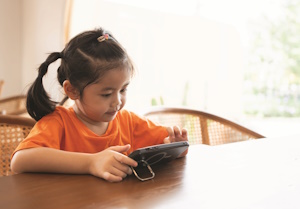Navigating Screen Time Recommendations with Neurodiverse Children
Attention Magazine August 2024
 In today’s digital age, managing screen time for children is a challenge many parents face. For those with neurodiverse children, such as those with ADHD or autism spectrum disorder (ASD), the challenge can be even greater.
In today’s digital age, managing screen time for children is a challenge many parents face. For those with neurodiverse children, such as those with ADHD or autism spectrum disorder (ASD), the challenge can be even greater.
Generalized screen time recommendations often fail to consider the unique needs and behaviors of neurodivergent children, leaving parents struggling to find effective strategies. This article explores the current screen time guidelines and their limitations for neurodiverse children and offers practical advice for parents navigating this complex issue.
Evolving screen time guidelines
Before 2016, the American Academy of Pediatrics emphasized strict screen time limits, advising no screen time for children eighteen to twenty-four months old, and limiting screen time to one hour per day for children two to five years old. Then, in 2016, the AAP revised its recommendations, emphasizing that the quality of screen time matters. The updated guidelines stress the importance of teaching children healthy media habits, fostering good digital citizenship, and discerning between different types of screens.
Similarly, a 2020 article published by the American Psychological Association highlighted the benefits of co-viewing with parents and underscored the correlation between excessive screen time and childhood obesity rates. Children under two years old benefit more from learning from a person rather than a screen, and most children fare better when they get enough sleep, physical activity, and have less screen time. However, achieving these criteria remains a challenge for many families.
Correlations between technology use and mental health
The correlation between smartphones and worsening mental health issues among children in the United States is evident. Excessive technology use has been linked to a range of adverse effects, including obesity, poor mental health, inadequate physical activity, insufficient sleep and diminished academic performance. Moreover, screen time before bed has been associated with suboptimal sleep quality for adults and children, further exacerbating these issues.
Jonathan Haidt, author of The Anxious Generation, advocates for delaying smartphone usage until high school and limiting social media access for children. These recommendations align with concerns about the negative impact of excessive screen time on mental health, particularly among neurodiverse youth. However, implementing such guidelines can be challenging for parents of neurodivergent children, who may rely on technology for communication, learning, and coping mechanisms.
Overall, the research concludes what most of us know regarding the direct outcome of too much or too early screen time. It’s not good—for kids, mental health, sleep, or general health.
Challenges for parents of neurodiverse children
While these recommendations provide valuable guidance for parents, they may not fully address the unique needs of neurodiverse children. Neurodiverse children may have sensory sensitivities, social difficulties, and communication challenges that can influence their relationship with technology. Some kids with various issues of neurodiversity may have underdeveloped social lives, lack supportive communities, and struggle to comply with behavioral expectations without severe meltdowns due to their mental health or developmental conditions.
- Behavioral and developmental differences. Neurodivergent children may struggle with social interactions and physical play. These children often find comfort and structure in screen-based activities, which can serve as coping mechanisms or learning tools. For example, a child with autism might use a specific app to enhance communication skills or regulate sensory input.
- Compliance and meltdowns. Parents of neurodiverse children often face significant challenges in enforcing screen time limits. For children with heightened sensory sensitivities or anxiety, abrupt changes to routine can trigger severe meltdowns. This makes it difficult for parents to implement the strict guidelines recommended by the AAP or APA.
- Assistive technology. Smartphones and tablets are not just sources of entertainment for neurodiverse children; they are often essential tools for learning and daily functioning. Technology can help to increase their understanding of social or environmental surroundings, practice social relatedness skills, improve their ability to express themselves better, grow their self-esteem, increase organizational skills, and bolster their functioning to make them more independent.Apps that offer visual schedules, communication aids, or social stories can be invaluable for children with developmental disabilities. Limiting access to these tools can hinder a child’s progress and independence.Many parents also need their kids to have smartphones with certain tech aids, such as Greenlight cards for cash, Google Maps for directions, or texting for communication. These modern tools help parents fulfill their work responsibilities while overseeing their family needs.
Practical strategies for managing screen time
Given the unique needs of neurodiverse children, here are some practical strategies parents can adopt to manage screen time more effectively.
Encourage healthy screen habits.
Model healthy screen habits yourself. Avoid allowing screens to disrupt or replace social interactions, and explain your screen use is for more than entertainment. Encourage your child to have screen-free time, take regular breaks, and engage in offline activities.

Avoid allowing screens to disrupt or replace social interactions, and explain your screen use is for more than entertainment.
Establish clear, consistent rules.
Develop clear and consistent rules around screen time that consider your child’s specific needs and preferences. Urge your child to complete other daily tasks, like homework, eating, sleeping or exercising, before using a screen. Also, set specific screen-free times, like during dinner or before bed.
Understand your child’s unique risks and adapt your guidelines.
Avoid using fear as a tool to set screen time limits and avoid limiting screen time. Rely on regular, positive conversations about screen use for your family.
Focus on quality—not all screens are equal.
Gaming is different from social media engagement. Purposeful gaming, or playing with goals in mind, is more productive than mindless gaming, or playing to escape or avoid other things.
Make screen time as productive as possible.
Identify your child’s skills during gaming or screen use and consider how they help your child in their daily lives.
Stay informed and adjust as needed.
Keep yourself informed on the current recommendations. Podcasts offer some of the most relevant content for families about managing technology. Check out Complicated Kids Podcast, Neurodiversity Podcast, Beautifully Complex, and Tilt. Regularly review and adjust your child’s screen time plan based on their evolving needs and responses. Be flexible and willing to adapt strategies that work best for your family.
By focusing on the quality of screen time, leveraging educational tools, and establishing clear, consistent rules, parents can help their neurodiverse children benefit from technology while minimizing potential risks.
A flexible, individualized approach is key
Navigating screen time recommendations for neurodiverse children is a complex task that requires a nuanced approach. While generalized guidelines offer a helpful starting point, they often need to improve in addressing the unique needs of neurodiverse children.
By focusing on the quality of screen time, leveraging educational tools, and establishing clear, consistent rules, parents can help their neurodiverse children benefit from technology while minimizing potential risks. Ultimately, a flexible, individualized approach is key to managing screen time effectively for neurodiverse children.


 Allison Sibley, PhD, LICSW, RPT-S, is a licensed independent clinical social worker in the District of Columbia with more than twenty years of experience treating families, couples, and adults. Her experience teaching, supervising, and researching parent-child treatments gives her a deep and abiding respect for the power of these treatments to change lives in profound and lasting ways. She leads groups for children and adolescents and offers individual, couples, and family therapy. Sibley earned a master’s degree in social work at Virginia Commonwealth University and a doctorate in clinical social work at Smith College. She has taught at the Washington School of Psychiatry, the School of Social Work at Catholic University of America, the Council for Social Work Education, and at the School for Social Work at Smith College. She speaks on topics that include social competence in children’s friendships, therapeutic play techniques for parents, parenting tweens and teenagers, and varied important topics related to family health and wellbeing.
Allison Sibley, PhD, LICSW, RPT-S, is a licensed independent clinical social worker in the District of Columbia with more than twenty years of experience treating families, couples, and adults. Her experience teaching, supervising, and researching parent-child treatments gives her a deep and abiding respect for the power of these treatments to change lives in profound and lasting ways. She leads groups for children and adolescents and offers individual, couples, and family therapy. Sibley earned a master’s degree in social work at Virginia Commonwealth University and a doctorate in clinical social work at Smith College. She has taught at the Washington School of Psychiatry, the School of Social Work at Catholic University of America, the Council for Social Work Education, and at the School for Social Work at Smith College. She speaks on topics that include social competence in children’s friendships, therapeutic play techniques for parents, parenting tweens and teenagers, and varied important topics related to family health and wellbeing.